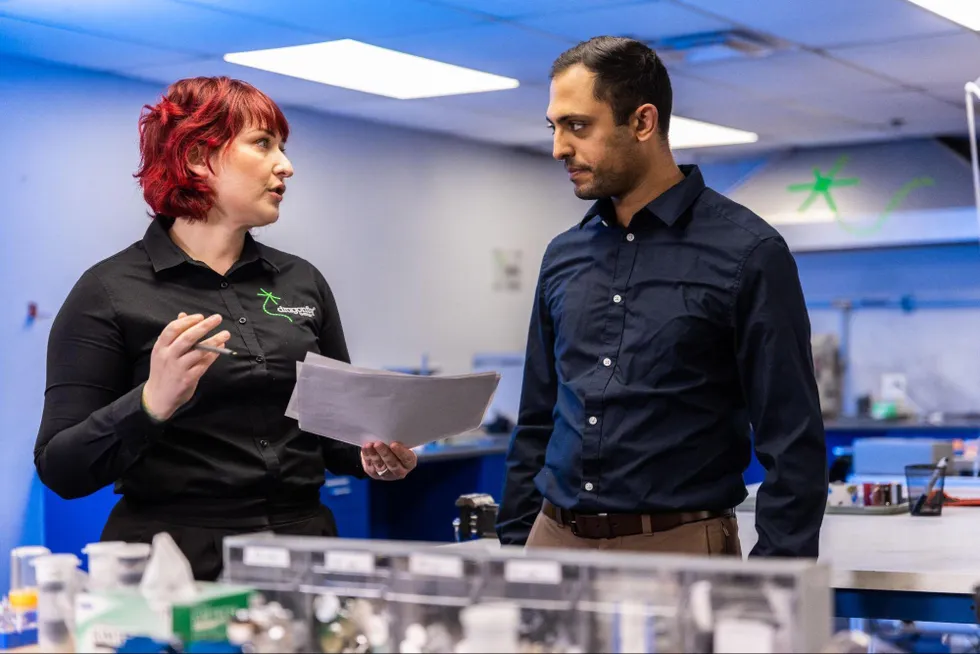Amid the devastating effects of climate change, there is a growing demand for renewable energy sources such as solar and wind, as an alternative to fossil fuels, which generate a lot of greenhouse gasses. However, since solar and wind energy are dependent on weather conditions, these power generation methods need batteries to store and provide power when the sun isn’t shining or the wind isn’t blowing.
Most grid energy storage systems today either don’t have integrated battery solutions or utilize antiquated lead-acid technology, which contain toxic chemicals that are harmful to the environment. While these technologies serve our current energy needs, to truly stabilize the grid and enable the widespread deployment of renewable energy sources, we need a better solution.
Dragonfly Energy, a comprehensive lithium battery and technology company based in Nevada, is leveraging its patented cell manufacturing technology to optimize the production of lithium batteries in the US. It has developed a dry deposition process that removes the use of toxic solvents, large manufacturing equipment, and reduces manufacturing costs resulting in a smaller carbon footprint. This chemistry-agnostic method can be applied to any type of lithium battery and paves the way for Dragonfly Energy to introduce its non-flammable solid-state batteries to the market.
According to Dragonfly Energy, a large part of the demand for lithium-ion batteries comes from the electric vehicle industry. However, electric vehicles won’t solve the energy problem, as the electricity needed to make them run has to come from somewhere. This is why the company seeks to revolutionize the power grid infrastructure by creating more efficient and cost-effective lithium-ion batteries to foster greater use of renewable energy sources.
Dragonfly Energy was founded in 2012 by Denis Phares, PhD, a former tenured professor of aerospace and mechanical engineering at the University of Southern California. For decades, Phares researched and worked on dry aerosol processes and nanotechnology. He came up with a new way to produce lithium-ion cells without the toxic solvents and with lower costs.
While this was an important development, energy storage solutions at that time were not yet developed or financially supported enough by industry leaders. However, there was an opportunity to replace lead-acid batteries, which are unreliable, bulky, inefficient, and more toxic with lithium-ion batteries in the recreational vehicle (RV), marine, and off-grid markets.
Phares says entering these markets allowed Dragonfly Energy to become profitable, especially its Battle Born Batteries brand, which was targeted both to consumers and Original Equipment Manufacturers (OEM). The profits were reinvested into research and development, allowing the company to continue to develop its dry deposition technology. Dragonfly Energy’s world-class team is working to use dry electrode processing to soon create non-flammable solid state cells.
In 2022, Dragonfly Energy went public (Nasdaq: DFLI), raising capital to unleash its patented cell manufacturing technology and bring domestic lithium batteries to market. This revolutionary method produces ideal solutions for energy storage applications, in addition to electric vehicles and consumer electronics batteries. This process will soon be able to produce solid-state, non-flammable batteries, which represent the next step of the technology. Once these batteries are released to the market, they will revolutionize how people consume and store energy.
Dragonfly Energy is also focused on creating a vertically integrated supply chain in its home base of Nevada. Currently, the majority of lithium iron phosphate cells are sourced from China, but there is a strong push from the country to onshore material sourcing and production. Dragonfly Energy aims to manufacture cells in Nevada using domestically sourced lithium. While there are US-based companies providing recycled lithium, it will take at least a few years for battery-grade lithium mines in Nevada to produce significant quantities, Phares says.
Another one of Dragonfly Energy’s innovations is the Dragonfly IntelLigence™ ecosystem, a lithium battery communication technology that controls and monitors what’s happening inside the packs at the cell level. It delivers that information via a wireless mesh network, integrating numerous battery packs into a single system, allowing users to be quickly informed about the status of their batteries. It can deliver battery information through common system protocols in addition to the cloud, allowing customers to monitor battery performance in large systems. This enables Dragonfly Energy to apply its own machine learning algorithms to understand how batteries age, fueling its ongoing research and development efforts.
“Many battery systems just add Bluetooth to the pack, allowing users to see the charge level, but nothing more,” Phares says. “At Dragonfly Energy, we do not want to just copy what everybody else is doing. We want to do things better and provide real value for the customers. With the Dragonfly IntelLigence™ system, we didn’t want to make just another smart battery. We wanted to create something revolutionary.”
Moving forward, Dragonfly Energy looks to expand its pilot line into a fully scalable solution that will produce non-flammable, solid-state cells that will be widely available to customers.
“We will continue to grow our core business, working to have lithium-ion batteries replace lead-acid batteries, which are an environmental nightmare. We are intent on continuing to provide that as an environmentally friendly solution. And, in the coming years, we are dedicated to making a true impact on transforming the US power grid, allowing for the majority of our energy to be generated from renewable energy sources,” Phares says.

